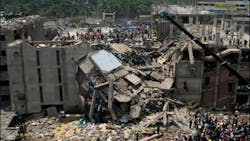Bangladesh Garment Worker Dies 108 Days After Disaster
DHAKA, Bangladesh -- A Bangladeshi garment worker who spent 108 days in a coma after being badly injured in one of the world's worst industrial disasters has died, officials said today.
Manwar Hossain, 22, was ironing clothes in one of the garment factories housed in the nine-story building outside the Bangladeshi capital when it collapsed on April 24, killing more than 1,100 people.
Hossain was among several thousand people pulled from the rubble at the time of the accident and taken to hospital.
"He was rushed here unconscious and died in a coma (last) Thursday," Zahidur Rahman, a director of the Enam Medical College and Hospital told AFP.
"He never woke up even for a second in 108 days," Rahman said. "His brain was damaged and both of his legs were also broken."
Hossain's parents were present when he died, Rahman said.
Toll Keeps Rising
The death toll from the disaster in the suburb of Savar, just outside the capital Dhaka, has risen from 1,129 to 1,134 in recent weeks, as more people died of their injuries, said Abdur Rashid, a local government official.
More than 3,000 workers were on shift at the Rana Plaza complex, where they made clothing for Western retailers including Britain's Primark and Spain's Mango, when it collapsed.
Several thousand people, mostly women workers, were rescued alive from the ruins of the building complex.
The tragedy highlighted the appalling safety conditions in the world's second-largest garment industry after China and forced Western retailers and the government to promise factory safety inspections.
Scores of distraught relatives are still waiting for news of missing loved ones after the disaster, with 329 people still officially unaccounted for, Rashid said.
Many of them are thought to be among the bodies recovered from the rubble that were too badly damaged or decomposed to identify.
Some of the unidentified bodies were buried at a graveyard in Dhaka after DNA samples were collected. The samples will eventually be matched with those taken from relatives of the missing to confirm their identity and compensate families.
Copyright Agence France-Presse, 2013
About the Author
Agence France-Presse
Copyright Agence France-Presse, 2002-2025. AFP text, photos, graphics and logos shall not be reproduced, published, broadcast, rewritten for broadcast or publication or redistributed directly or indirectly in any medium. AFP shall not be held liable for any delays, inaccuracies, errors or omissions in any AFP content, or for any actions taken in consequence.
